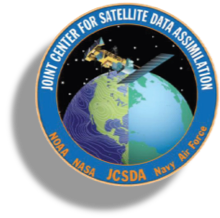Anna Shlyaeva (UCAR, JCSDA), Clara Draper (NOAA/PSL, JCSDA), Benjamin Menetrier (Norwegian Meteorological Institute), Travis Sluka (UCAR, JCSDA), Cory Martin (NOAA/EMC, JCSDA), Benjamin Ruston (UCAR, JCSDA), Tseganeh Gichamo (Lynker at NOAA/EMC)
The presence and amount of snow on the ground is key to many modeling problems since snow has a profound impact on the surface's radiative and thermal properties. Accurate snow analysis can then be important for achieving skillful weather forecasts due to the aforementioned impacts on the near-surface atmosphere. The snow pack is also an important source of terrestrial water in many regions and it is particularly important for predicting summer water supplies in many arid mountain regions, including the Rocky Mountain West.
With recent advances, JEDI can now perform variational (2DVar) data assimilation for snow depth analysis. The flexibility of JEDI and the generic implementations of data assimilation algorithms (in OOPS) and background error covariances (in SABER, System Agnostic Background Error Representation) enabled a rapid development of this system for snow depth analysis.
Within NWP, land data assimilation systems have evolved separately from atmospheric data assimilation systems, and land data assimilation typically uses comparatively simple methods (Balsamo et al 2018). For example, many NWP centers use an optimal interpolation algorithm for their snow depth analysis (Gichamo and Draper 2022, Brasnett 1999, Luijting et al 2018).
Over the last several years NOAA PSL and JCSDA have been working on developing a JEDI-based data assimilation system for snow depth analysis, based on an approximation to the optimal interpolation algorithm implemented in the Local Ensemble Transform Kalman Filter (LETKF) framework in JEDI (Frolov, 2022). This work included setting up configuration of the snow depth observations, in particular observation operators and quality control filters. Due to the flexibility of JEDI, the same observation configurations can be used with any data assimilation algorithm, and this work positioned JEDI to quickly set up a 2DVar snow depth analysis.
Variational data assimilation requires specification of the background error covariances. SABER is the part of JEDI that contains different generic implementations of background error covariance operators and allows the users to mix and match different available covariance operators to set up the best background error covariance for their application. Background error covariances used in operational (OI-based) snow DA are comparatively simple: isotropic homogeneous horizontal correlations with a single length scale, vertical correlations based on difference in the orography and the same value of background error variance across the globe.
The horizontal correlation operators currently available in SABER are: NICAS (Normalized Interpolated Convolution on an Adaptive Subgrid) smoother (Menetrier 2020), spectral analytical filter (developed in JEDI by Marek Wlasak and Mayeul Destouches), and an explicit diffusion operator (https://doi.org/10.1002/qj.3918, developed in JEDI by Travis Sluka). NICAS and the explicit diffusion implementations can handle vertical correlations as well as horizontal. The development of snow depth background error covariances that take into account the difference in orography have led to a new background error covariance operator recently developed by Benjamin Menetrier and implemented in JEDI (Menetrier, 2024: https://doi.org/10.5281/zenodo.13151313). This “shadow levels” method convolutes 2D variables over mountains and areas with lots of vertical relief at far reduced computational cost than a full 3D convolution. The method splits the 2D field on user-defined vertical levels, applies a horizontal correlation operator independently on each level, and finally gathers the results back into a single 2D field. The weights used to split and gather the fields take a vertical correlation length-scale into account.
Figure 1. Mean absolute error in snow depth [mm] against independent station observations, from an Open Loop (OL) with no data assimilation, and Optimal Interpolation (OI) and JEDI 2DVar snow depth data assimilation experiments. Both data assimilation experiments assimilate station snow depth from the Global Historical Climatology Network Daily dataset.
For snow 2DVar in JEDI, several background error covariances were set up with similar error covariance length scales and variances: 3D convolution with NICAS, horizontal convolution with NICAS using “shadow levels” for vertical correlations, and horizontal explicit diffusion using “shadow levels” for vertical correlations. All of the methods give qualitatively similar results, also similar to those provided by the optimal interpolation implemented in Gichamo and Draper (see Figure 1). 2DVar using horizontal convolution with NICAS and “shadow levels” for vertical correlations is currently being targeted for implementation for operational use as part of the next major upgrade to NOAA’s Global Forecast System. This covariance configuration was chosen out of all the considered background covariances because it’s currently the most computationally efficient, thanks to recent improvements in the NICAS operator and development of the “shadow levels” method by Benjamin Menetrier.
The development of snow depth variational DA is a clear demonstration of how the advancement in the JEDI generic code allows for quick scientific progress in new applications, as well as how the scientific use of JEDI with the new applications drives even more computational and scientific improvements.
Bibliography:
Remote Sens. 2018, 10(12), 2038; https://doi.org/10.3390/rs10122038
Balsamo et al, Satellite and In Situ Observations for Advancing Global Earth Surface Modelling: A Review
Gichamo, T. Z., and C. S. Draper, 2022: An Optimal Interpolation–Based Snow Data Assimilation for NOAA’s Unified Forecast System (UFS). Wea. Forecasting, 37, 2209–2221, https://doi.org/10.1175/WAF-D-22-0061.1.
Brasnett, B., 1999: A global analysis of snow depth for numerical weather prediction. J. Appl. Meteor. Climatol., 38, 726–740, https://doi.org/10.1175/1520-0450(1999)038<0726:AGAOSD>2.0.CO;2.
Luijting, H., Vikhamar-Schuler, D., Aspelien, T., Bakketun, Å., and Homleid, M.: Forcing the SURFEX/Crocus snow model with combined hourly meteorological forecasts and gridded observations in southern Norway, The Cryosphere, 12, 2123–2145, https://doi.org/10.5194/tc-12-2123-2018, 2018.
Benjamin Menetrier. (2024). benjaminmenetrier/shadow_levels: 2024-10-29 version (1.0). Zenodo.https://doi.org/10.5281/zenodo.14007355
Photo by Johny Goerend on Unsplash


